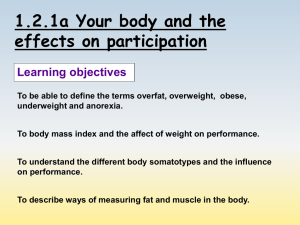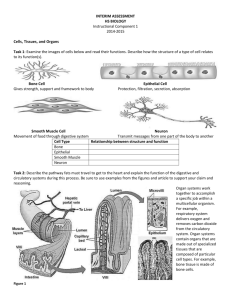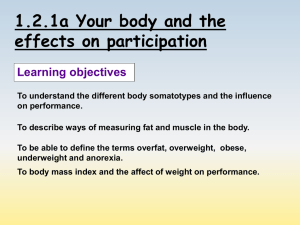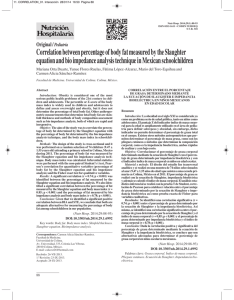BMI Accuracy Lab Report: Clemson University Study
advertisement
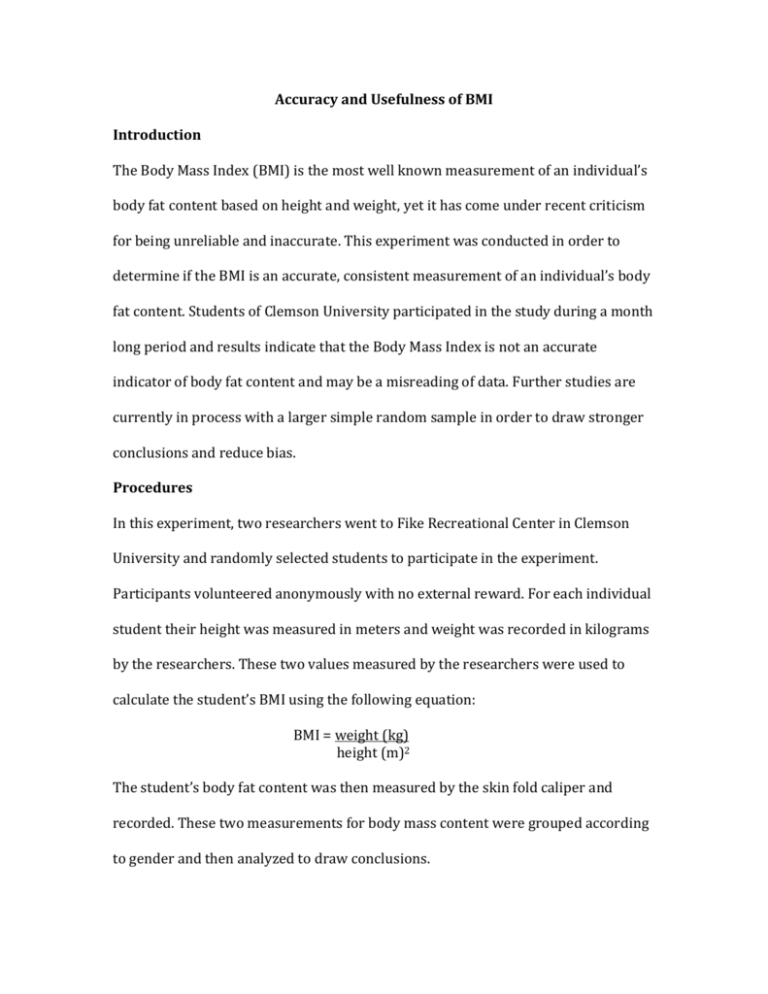
Accuracy and Usefulness of BMI Introduction The Body Mass Index (BMI) is the most well known measurement of an individual’s body fat content based on height and weight, yet it has come under recent criticism for being unreliable and inaccurate. This experiment was conducted in order to determine if the BMI is an accurate, consistent measurement of an individual’s body fat content. Students of Clemson University participated in the study during a month long period and results indicate that the Body Mass Index is not an accurate indicator of body fat content and may be a misreading of data. Further studies are currently in process with a larger simple random sample in order to draw stronger conclusions and reduce bias. Procedures In this experiment, two researchers went to Fike Recreational Center in Clemson University and randomly selected students to participate in the experiment. Participants volunteered anonymously with no external reward. For each individual student their height was measured in meters and weight was recorded in kilograms by the researchers. These two values measured by the researchers were used to calculate the student’s BMI using the following equation: BMI = weight (kg) height (m)2 The student’s body fat content was then measured by the skin fold caliper and recorded. These two measurements for body mass content were grouped according to gender and then analyzed to draw conclusions. Results and Discussion The experiment went as expected with no unusual events or unpredictable data points. A total of 57 men and 44 women measured to find the following data: Men Women Body Mass Index 27.6 26.1 Skin Fold Caliper 22.2 23.9 Given our sample, we concluded that the Body Mass Index was significantly higher than the body fat content measured using the Skin Fold Caliper. There are many explanations for this; however, exact cause of the misreading using BMI can only be determined with further studies and research. Upon further literary research, we found that others studies concluded that BMI is an inaccurate indicator of body fat content. BMI does not take into account muscle mass, bone density, overall body composition and racial and sex differences during calculation. Even though it takes an individual’s raw data and translates it into a scale of numbers used to compare body fat content, these raw data points are biased and therefore lead to an inaccurate number. An individual’s muscle mass and bone density are mistranslated as fat content in the individual and give an inaccurate reading. Even though Body Mass Index seems like an accurate measurement of body fat content, current literature and studies have found that many other measurements are more accurate. Although the results found were statistically significant, they may have been drawn from an unrepresentative sample. The sample used to measure BMI was taken from students at the Fike Recreational Center at Clemson University, which is the local gym on the college campus. It may be assumed that these students are more conscientiously aware of their weight and body fat content and therefore will have lower BMIs. In experiments it is normally best to draw data from a simple random sample, where each individual in the population has an equally likely chance of being picked to participate in the student. Samples with a larger sample size, or more participants, are generally more valid due to the large number of participants being able to outweigh potential outliers in analysis. It is likely that bias was introduced into the sample due to convenience sampling and having a smaller sample size. Although the bias may not be apparent and cannot be directly measured, it may be in the sample and could affect the outcome of the study. Conclusion Overall, the experiment succeeded in measuring the body fat content of 101 college students at Clemson University using both the Body Mass Index and Skin Fold Caliper methods. The two methods were compared, with the Skin Fold Caliper method being the accepted true value, and it was found that the BMI was inaccurate and a misrepresentation of the individual’s true body mass content. Further research on this subject is being planned with a larger sample size and simple random sample in order to reduce bias and produce stronger data. References: "5 Ways To Measure Body Fat Percentage - BuiltLean." BuiltLeancom 5 Ways to Measure Body Fat Percentage Comments. 13 July 2010. Web. 30 Apr. 2015. <http://www.builtlean.com/2010/07/13/5-ways-to-measure-body-fatpercentage/>. "Accuracy and Usefulness of BMI Measures Based on Self-reported Weight and Height: Findings from the NHANES & NHIS 2001-2006." BMC Public Health. Web. 30 Apr. 2015. <http://www.biomedcentral.com/1471-2458/9/421>. Medical News Today. MediLexicon International. Web. 30 Apr. 2015. <http://www.medicalnewstoday.com/articles/265215.php>. "Normal Weight Ranges: Body Mass Index (BMI)." Normal Weight Ranges: Body Mass Index (BMI). Web. 30 Apr. 2015. <http://www.cancer.org/cancer/cancercauses/dietandphysicalactivity/bodyweighta ndcancerrisk/body-weight-and-cancer-risk-adult-bmi>. Model of Lab Report: "Sample Lab Report #2." Sample Lab Report #2. Web. 30 Apr. 2015. <http://writing.engr.psu.edu/workbooks/labreport2.html>.





